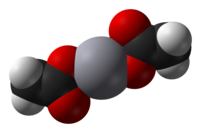Mercuric acetate
 |
|
 |
|
 |
|
| Names | |
|---|---|
| Other names
mercuric acetate
mercuriacetate |
|
| Identifiers | |
|
3D model (JSmol)
|
|
| ChEBI | |
| ChemSpider | |
| ECHA InfoCard | 100.014.993 |
|
PubChem CID
|
|
| UNII | |
|
|
|
|
| Properties | |
| C4H6O4Hg | |
| Molar mass | 318.678 g/mol |
| Appearance | white-yellow crystals |
| Odor | mild vinegar odor |
| Density | 3.28 g/cm3, solid |
| Melting point | 179 °C (354 °F; 452 K) (decomposes) |
| 25 g/100 mL (10 °C) 100 g/100 mL (100 °C) |
|
| Solubility | soluble in alcohol, diethyl ether |
| −100·10−6 cm3/mol | |
| Hazards | |
| NFPA 704 | |
| Lethal dose or concentration (LD, LC): | |
|
LD50 (median dose)
|
40.9 mg/kg (rat, oral) 23.9 mg/kg (mouse, oral) |
|
Except where otherwise noted, data are given for materials in their standard state (at 25 °C [77 °F], 100 kPa).
|
|
|
|
|
| Infobox references | |
Mercury(II) acetate is the chemical compound with the formula Hg(O2CCH3)2. Commonly abbreviated Hg(OAc)2, this compound is employed as a reagent to generate organomercury compounds from unsaturated organic precursors.
Mercury(II) acetate is a crystalline solid consisting of isolated Hg(OAc)2 molecules with Hg-O distances of 2.07 Å. Three long, weak intermolecular Hg···O bonds of about 2.75 Å are also present, resulting in a slightly distorted square pyramidal coordination geometry at Hg.
Arenes undergo "mercuration" upon treatment with Hg(OAc)2. The one acetate group that remains on mercury can be displaced by chloride:
The Hg2+ center binds to alkenes, inducing the addition of hydroxide and alkoxide. For example, treatment of methylacrylate with mercuric acetate in methanol gives an α-mercuri ester:
Mercury(II) has a high affinity for sulfur ligands. Hg(OAc)2 can be used as a reagent to remove the acetamidomethyl protecting group, which is used to "protect" thiol groups in organic synthesis. Similarly Hg(OAc)2 is a standard reagent to convert thiocarbonate esters into dithiocarbonates:
Mercury(II) acetate is used for oxymercuration reactions.
...
Wikipedia

